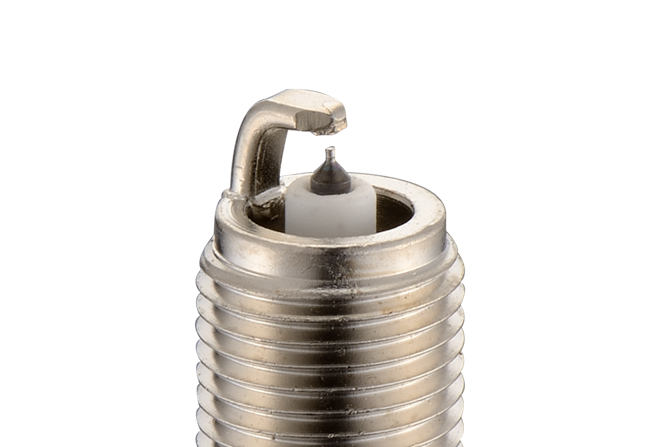Content
Break through the gas mixture (air/natural gas or biogas) at a high voltage of 15-30kV to form a 5-10mm plasma fire core with an ignition energy of 50-100mJ (3-5 times that of automotive spark plugs).
Industrial specificity: The lean combustion of gas engines (λ=1.6-2.0) requires spark plugs to have stronger penetration.
Avoid the detonation tendency of gas engines through precise ignition timing (±0.1° crankshaft angle accuracy) (methane octane number MON 120, but biogas contains CO₂, which is easy to cause misfires).
High temperature tolerance: The center electrode needs to withstand 2000℃ instantaneous high temperature + continuous 800℃ working conditions (comparison: automotive spark plugs are usually ≤700℃).
Material solution: iridium electrode (melting point 2450℃) + alumina ceramic insulator (thermal conductivity 30W/m·K).
Chemical corrosion resistance: Resist electrochemical corrosion caused by H₂S (hydrogen sulfide) in biogas (2H₂S + O₂ → 2S + 2H₂O, sulfur corrodes the electrode).
Voltage adaptation: Industrial spark plugs can work stably in a wide voltage range of 10-40kV (adapting to the changes in breakdown voltage caused by fluctuations in gas composition).
Misfire monitoring interface: High-end models integrate ion current detection function and provide real-time feedback of combustion status to ECU.
Heat value management: Through the selection of hot (slow heat dissipation)/cold (fast heat dissipation) spark plugs, the electrode temperature is controlled in the self-cleaning range of 450-850℃.
Industrial standard: Natural gas engines generally use cold spark plugs.
Electrode status
Normal: The center electrode is gray-brown, and the gap is 0.5-0.8mm
Abnormal: Electrode erosion → ignition voltage is too high (check coil/capacitor), white powder deposition → silicon pollution (replace gas filter), green copper rust → H₂S corrosion (need desulfurization treatment)
Insulator cracks
Use a 10x magnifying glass to check the radial cracks of the ceramic body (indicating thermal shock damage)
Method: Use a megohmmeter to measure the insulation resistance (>100MΩ at 20℃ is normal)
Typical faults: resistance <10MΩ → ceramic carbonization leakage, resistance ∞ → internal short circuit (replace spark plug)
Tool: Non-magnetic plug gauge (avoid damage to precious metal electrodes)
Correction standard: Adjust the gap to the standard value ±0.05mm every 1000 hours
Professional equipment: Use an adjustable high-voltage test bench (simulating 15-40kV working conditions)
Qualification standard: 10 consecutive stable sparks at 30kV (spark length ≥ 8mm)
Implementation steps:
Install an oscilloscope and connect the secondary ignition circuit
Analyze the combustion ion current waveform
Fault judgment: shape amplitude <50mV→mixed gas is too lean, waveform jitters→electrode carbon deposition causes intermittent misfire
Operation specification: Scan the spark plug after the engine runs at full load for 30 minutes
Temperature standard: Insulator temperature >500℃→thermal type mismatch, electrode temperature difference >150℃→cooling channel blockage
Failure analysis items: SEM scanning electron microscope: observe electrode micro-melting, EDS energy spectrum analysis: detect sulfur/silicon pollutant components
|
Fault phenomenon |
Possible causes |
Targeted solutions |
|
Difficult cold start |
Spark plug heat value is too high (fast heat dissipation) |
Replace hot type spark plug |
|
Misfire at high load |
Electrode gap is enlarged by knock impact |
Add knock sensor + adjust ignition advance angle |
|
Periodic power fluctuation |
Carbon bridge formation on insulator surface |
Use anti-carbon deposit spark plug with surface nitriding treatment |
|
Abnormal exhaust temperature rise |
Spark plug leakage causes combustion delay |
Replace spark plug with metal sealing gasket |
Phenomenon: Spark plug life dropped from 2000 hours to 500 hours
Diagnosis: EDS analysis found that the sulfur content of the electrode exceeded the standard (3.5wt%)
Solution: Install a dry desulfurization tower (H₂S dropped from 200ppm to <50ppm)
Phenomenon: Misfire rate >2% at high load
Diagnosis: Thermal imager showed local overheating of the insulator (620℃)
Solution: Replace cooling spark plugs + optimize cylinder head water channel design

Electrode wear
Check the degree of wear of the center electrode and the ground electrode. If the electrode becomes noticeably thinner, shorter, or pitted, the spark plug has worn out.
If the diameter of a precious metal electrode (such as iridium or platinum) decreases by more than 0.2 mm, or a nickel alloy electrode decreases by more than 0.5 mm, it must be replaced.
Abnormal electrode gap
Use a plug gauge to measure the electrode gap, and the standard value is usually between 0.5-0.8 mm.
If the gap exceeds the allowable range (such as exceeding the standard value ±0.05 mm) due to corrosion or ablation, it needs to be adjusted or replaced.
Cracks or breakage of the insulator
Cracks, chipping, or surface carbonization of the ceramic insulator will cause high-voltage leakage and must be replaced.
Use a magnifying glass to check for fine cracks, especially at the root of the insulator, as cracks may cause fires.
Abnormal deposits
White powder: Silicon contamination (gas contains silicon compounds), which requires replacement and inspection of the gas filtration system.
Green copper rust: Hydrogen sulfide corrosion (biogas contains sulfur), which requires replacement of corrosion-resistant spark plugs and optimization of the desulfurization process.
Black oily carbon deposits: Engine oil seeps into the combustion chamber and the piston ring sealing needs to be checked.
Difficulty starting or ignition failure
The cold start time is significantly extended (such as exceeding the standard value by 50%), or multiple ignitions are required to succeed.
Possible reasons: Spark plug electrode wear, excessive gap or insulator leakage.
Engine power reduction
The output power is reduced, or the misfire rate increases during high-load operation (such as knocking times > 5 times/minute).
Possible reasons: Insufficient spark plug ignition energy or mismatched calorific value.